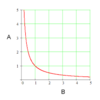Practical skills - paper 1 and 2 COPY Flashcards
To revise key practical terms (Paper 1 and 2)
Define an independant variable
The one variable that you change
Define a dependant variable
The variable that you measure
Define a control variable
Any variable you keep the same to make it a fair test
Define directly proportional
If one variable increases the other variable increases at the same rate. eg if x doubles then y must double.
A graph would be a straight line** through the **origin

Define inversely proportional
If one variable increases the other variable decreases at the same rate. eg if x doubles then y must halve

Define an anomalous result
An result which does fit the pattern of trend

What should you do if you have an anomolus result?
Repeat the reading
Ignore it when calculating the average
Circle on the graph and not include it in your line of best fit
Define interval
The spacing between measurements eg 0, 10, 20, 30 40, 50 cm would have an interval of 10 cm
Define range
The maximum and minimum values eg 0, 10, 20, 30, 40, 50 cm would have a range of 50 to 0 cm
Define resolution
The smallest change that can be measured with a particular piece of equipment
If a stop clock reads 18.72 seconds, what is its resolution?
0.01 s
If a voltmeter reads 3.6 V what is its resolution?
0.1 V
How can the uncertainty in a measurement be measured?
Half of the range
When should you draw a line graph
When both variables are continuous
When should you draw a bar graph
If one of the variables is discrete or categoric
Define a continuos variable
Can be recored as any number eg time, mass, volume
Define a discrete variable
Can be recored only as a whole number eg number of goals in a match, leaves on a plant
Define a catergoic variable
Is recorded in words instead of numbers eg colours or types of metal
Vernier calipers can measure distance to the nearest 0.01 cm. A meter ruler can measure to the nearest 0.1 cm. Which would be better for measuring the width of an object?
The Vernier calipers have a higher** resolution. The meter ruler has a **lower resolution. The Vernier calipers would be more accurate.
How can you convert from cm3 into m3?
Divide by 1000000 (1003)
How can you convert from mm3 into m3?
Divide by 1000000000 (10003)
Define a random error and give an example
A random error is an error in a measurement that is different each time. This causes points to be scattered around a line of best fit on a graph.
An example would be using a stopwatch and starting or stopping it too early

Define a systematic (zero) error and give an example
An error that will be the same on all measurements. For example an electronic balance that reads 0.05 g before anything is place on it. All readings will be 0.05 g too high.

If an electronic balance has a zero error (records a reading when it should say 0.00 ) how could this be corrected?
- Reset the balance to zero
- Record the zero error and add or subtract it from all your measurements
What are the benefits of peer review?
detects false claims
detects inaccurate data
detects bias
verifies new data
How can you check if results are precise?
Take repeat readings. If the results are close together then they are precise.
What are the benefits of repeat readings?
Spot anomalies
Calculate an average
The average should reduce the effect of random errors.
What is the difference between accurate readings and precise readings?
Accurate readings - average will be close to the true value
Precise readings - repeat readings will be close to each other



